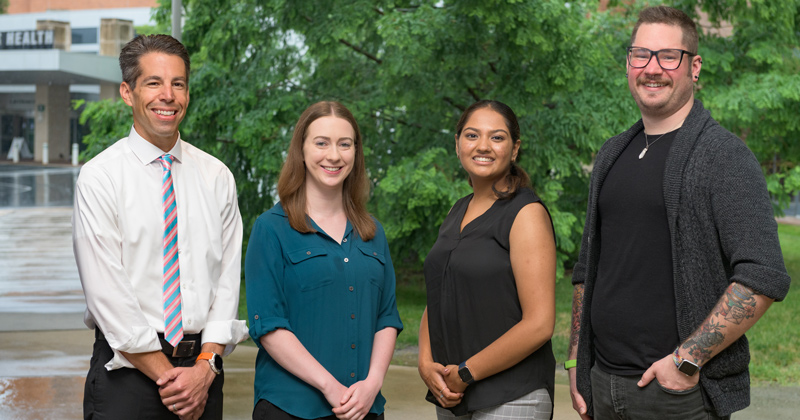
Fit matters. You know this if you’ve ever walked in shoes that are too small, put on someone else’s prescription glasses or heard your child’s name mispronounced over a loudspeaker.
Fit matters a lot in healthcare, too. Doctors, nurses and others in the medical arts need good data — complete, accurate, timely data — to provide optimal care to patients, each of whom arrives with much different backgrounds and needs.
But patient information isn’t always accurate or complete and that can be especially problematic when trying to understand the needs of specific populations, such as those who are lesbian, gay, bisexual, transgender or queer (LGBTQ).
An estimated 7.1% of Americans identify as LGBTQ, according to a Gallup poll released earlier this year. The poll, taken in 2021, shows an increase from the 5.6% reported in a 2020 poll. Of those who identified as LGBTQ, 10% said they were transgender, meaning their gender identity does not match the sex assigned them at birth. They represent just under 1% of the overall American population, Gallup said.
Now a study by researchers at the University of Delaware and ChristianaCare shows how incorrect or incomplete data can be an obstacle to ensuring equitable healthcare for transgender patients and others in the LGBTQ community.
The study, published by the journal Transgender Health, reflects information gathered in interviews with 37 hospital registrars at Christiana Hospital in New Castle County, Delaware.
The interviews — conducted in 2017, then transcribed and analyzed in 2020 — show how hospital registrars’ attitudes and practices affected collection of gender identity data, how they responded to systemic barriers and what they did when they encountered discrepancies in documentation.
Four researchers worked on the study, including UD Honors College senior Shivani Mehta, who is majoring in neuroscience and plans to attend Sidney Kimmel Medical College; Alex Waad, a program manager in ChristianaCare’s Office of Health Equity and a doctoral student at UD; Madeline Brooks of Christiana Care’s Institute for Research on Equity and Community Health (iREACH); and Scott Siegel, a licensed psychologist, director of Population Health Research within iREACH and an adjunct professor at UD.
“Many institutions do not collect data regarding sexual orientation and gender identity,” Waad said. “However, we do know that our LGBTQ communities face disproportionate stigma in the healthcare space in comparison to their cisgender-heterosexual counterparts. The only reason we know this is because others have made data collection a priority. Put simply, if we don’t collect data, we aren’t able to identify or address disparities.”
Sometimes the obstacles to data collection are quite basic. Researchers found, for example, that hospital registrars encountered technical problems as they tried to enter patient information into computer systems. The forms permitted just two options for gender identity: male or female. There was no way to provide information on a patient who identified as transgender or otherwise non-binary.
“Even though some registrars had misconceptions about gender identity, they wanted to request this information in a respectful way,” Brooks said. “However, electronic health records often fail to capture patients’ non-binary gender identities. Then we risk marginalizing patients and recording inaccurate information.”
Brooks said she had been part of previous studies of how hospital registrars collect data on race, ethnicity and language information.
“We found that registrars were sometimes uncertain about why we ask for this or afraid that they might offend patients,” she said. “We heard their concerns and adapted our training accordingly.
“It’s critical to have demographic data so we can track potential disparities and provide culturally competent care to all our patients. We needed to know if registrars faced similar challenges in collecting gender identity.”
With only two gender choices offered in the computer program, registrars had to decide whether to report gender based on physical anatomy, the patient’s response to the question or to rely on information recorded on a legal document, such as a driver’s license. This kind of uncertainty produces confusion, skewed information and corrupted data.
“Getting into healthcare information technology is as complicated as it comes,” Siegel said. “The lab has a system, radiology may have a different system and external vendors may have a completely different system.”
Insurance companies have their own forms. Pharmacies have their own forms. Getting all of that coordinated and up to date is challenging.
“Without systems that can accommodate transgender information in the patient demographics, it’s hard for registrars to accurately and respectfully collect patient information, even when they try their best,” Siegel said. “We recognize it will be a lot of work to update our electronic health record systems, but we need to do that work.”
Leaders at ChristianaCare have supported efforts to work with information technology systems and external vendors to develop better systems and processes and that work continues.
“ChristianaCare is committed to moving forward with more respectful and inclusive collection of patient sexual orientation/gender identity data, in addition to other important pieces of information for the healthcare environment — such as preferred name, pronouns and eventually organ and surgical inventories,” Waad said. “We are currently working — and have been for multiple years — with our electronic health record vendor to raise awareness of these gaps and the need for change.”
Mehta, the first author on the paper, said she was chosen to work on this project with her mentors, Brooks and Waad, by the Delaware INBRE (IDeA Network of Biomedical Research Excellence) program. Delaware INBRE supports undergraduate research training opportunities, among other activities, with funding from the National Institute of General Medical Sciences at the National Institutes of Health. Siegel is the institutional lead for Delaware INBRE at ChristianaCare.
“It paves the way for electronic health systems to allow hospitals to collect inclusive patient information such as gender identity, sexual orientation, pronouns and more,” she said. “Using these demographics, we can track health disparities among the LGBTQ groups and create evidence-based interventions to decrease these inequities.”
Siegel said Mehta made important contributions to the work and to development of the journal article.
“Shivani, to me, represents the best of the next generation,” he said. “I have hope that they’re way more open-minded and I have found that they’re more understanding that gender is less of a binary. Everybody can identify in different ways. We can feel compassion for the harms that rigid ways of thinking can cause. For her, it was a natural fit and she did a great job.”
Researchers noted several limitations of the study. It included a small number of participants who represented one hospital. The interviews analyzed now are five years old and the attitudes and experiences of those registrars may have changed in the interim.
But, Siegel said, the goal of ensuring equitable healthcare remains firm.
“We’re taking this to heart,” he said. “The hard work is getting all these processes and systems to work…. From the moment someone walks in the door, we need our processes to support a positive and affirming experience.”








